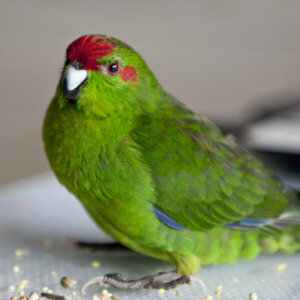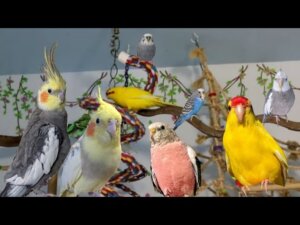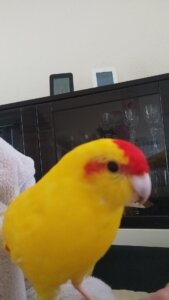How To Know If Your Kakariki Is Happy: 7 Clear Signs
Knowing if your Kakariki is happy can be simple. Happy birds show clear signs.
Kakarikis are vibrant and social birds. Their happiness is essential for their health. Understanding their behavior helps ensure they are content. A happy Kakariki will engage in playful activities, sing, and interact positively with you. Observing these behaviors can give you insights into their well-being.
In this blog post, we will explore the telltale signs of a happy Kakariki. From their vocalizations to their body language, each indicator will help you understand your feathered friend’s mood. Whether you are a new bird owner or experienced, these tips will guide you in keeping your Kakariki cheerful and healthy. Let’s dive in and learn more about these delightful birds.
Bright And Vibrant Plumage
One of the most noticeable indicators of a happy Kakariki is its bright and vibrant plumage. A bird’s feathers can tell a lot about its health and mood. If your Kakariki has healthy, colorful feathers, it is likely content and well-cared for. Let’s explore the signs of happy plumage in more detail.
Healthy Feather Condition
Healthy feathers are smooth and well-aligned. They should not have any bald patches or fraying edges. If your Kakariki is preening regularly, its feathers will stay in top condition. Preening helps remove dirt and keeps feathers waterproof.
Color Intensity
Color intensity is another key factor. Happy Kakarikis have bright, vivid feathers. Dull or faded plumage might indicate stress or poor health. A balanced diet rich in nutrients enhances feather color. Make sure your bird has access to fresh fruits and vegetables.
Active And Playful Behavior
Understanding your Kakariki’s happiness can be tricky. But, observing their active and playful behavior is a great start. Happy Kakarikis are full of energy and love to explore their surroundings. Let’s dive into some key signs.
Frequent Movement
Happy Kakarikis rarely stay still. They flutter from perch to perch. They climb around their cage with ease. This frequent movement shows they are healthy and content.
Here’s a quick checklist to observe:
- Regular flying or hopping
- Active climbing
- Stretching wings often
Curiosity And Exploration
Curious Kakarikis are happy Kakarikis. They explore every corner of their cage. They play with toys and interact with their environment. This shows they are mentally stimulated.
Signs of curiosity include:
- Investigating new items
- Playing with toys
- Pecking at different objects
Provide your Kakariki with different toys. Rotate them to keep things interesting. This will help maintain their curiosity and happiness.
Vocalization And Singing
Kakarikis are known for their lively and expressive nature. One of the best ways to know if your Kakariki is happy is through their vocalization and singing. Happy Kakarikis will often engage in various forms of vocal expressions. These vocalizations can range from chirping to mimicking sounds they hear in their environment. Understanding these vocal cues can help you gauge your bird’s happiness.
Chirping And Whistling
Chirping and whistling are common signs of a content Kakariki. When your bird is happy, you will hear soft, melodic chirps throughout the day. These sounds are often random and not very loud.
Whistling is another positive sign. A happy Kakariki may whistle simple tunes or repeat sounds they find pleasing. These vocalizations are usually high-pitched and clear.
| Chirping | Whistling |
|---|---|
| Soft and melodic | High-pitched and clear |
| Random and varied | Simple tunes |
Mimicking Sounds
Mimicking sounds is another sign of a happy and engaged Kakariki. These birds are great at imitating noises they hear around them. They might mimic your voice, household sounds, or other birds.
When a Kakariki mimics sounds, it shows they are mentally stimulated and comfortable in their environment. They enjoy engaging with their surroundings and showing off their vocal skills.
Listening to your Kakariki’s vocalizations can give you valuable insights into their mood and well-being. Happy birds will be vocal and expressive, making a variety of sounds that indicate their contentment.
Healthy Appetite
Monitoring your Kakariki’s healthy appetite is crucial to ensure their well-being. A healthy Kakariki will have consistent eating habits. They will also show excitement for their meals and treats. Let’s explore how a Kakariki’s appetite can indicate their happiness.
Regular Eating Patterns
A happy Kakariki will have regular eating patterns. Observe if they eat at similar times each day. Consistency in meal times shows they are comfortable and content. If their eating habits change, it may indicate stress or illness. Keep track of their daily food intake.
- Eat at similar times daily
- Consume a consistent amount of food
- Show excitement during meal times
Enjoyment Of Treats
Your Kakariki’s response to treats is another sign of happiness. A happy Kakariki will eagerly accept their favorite snacks. They might even perform tricks or display excitement when offered a treat.
Ensure the treats are healthy and offered in moderation. Overfeeding treats can lead to health issues. Observe their enthusiasm for different types of treats to understand their preferences.
| Treat | Reaction |
|---|---|
| Fruit | Excited and eager |
| Seeds | Happy and playful |
| Vegetables | Interested and curious |
Social Interaction
Kakarikis are social birds. They thrive on interaction and companionship. Observing their social behavior helps gauge their happiness. Let’s explore how bonding with owners and positive interaction with other birds can indicate a happy Kakariki.
Bonding With Owners
Kakarikis love spending time with their human companions. They enjoy sitting on your shoulder, mimicking your actions, and sharing small treats. When your Kakariki eagerly approaches you, it’s a sign of a strong bond. They might even follow you around the house. This shows trust and affection. Vocalizing softly and preening in your presence also indicate contentment.
Regular interaction is key. Spend at least an hour daily with your bird. Talk to them gently. Offer toys and engage in play. This interaction boosts their mood and strengthens your bond. A happy Kakariki is an interactive and curious bird.
Positive Interaction With Other Birds
Kakarikis are social with other birds too. Observe their behavior around feathered friends. They enjoy playing and grooming each other. If your Kakariki actively participates in group activities, it’s a good sign. They might share food or toys, indicating a happy demeanor.
Watch for signs of aggression. Happy Kakarikis are friendly and non-aggressive. They thrive in a harmonious environment. Ensure they have enough space to interact freely. This fosters positive relationships and keeps them content.

Credit: www.facebook.com
Regular Preening
Regular preening is a clear sign of a happy Kakariki. Preening helps Kakarikis maintain their feathers and overall health. It’s a natural behavior that shows your bird is content.
Grooming Feathers
Grooming feathers is a common activity for Kakarikis. They use their beaks to clean and align their feathers. This keeps their feathers in good condition. A happy Kakariki will often spend time grooming. Watch your bird closely. Frequent grooming shows your bird feels safe and comfortable.
Bathing And Cleaning
Bathing is another important part of preening. Kakarikis love to bathe in water. This helps them clean their feathers and skin. Provide a shallow dish of water for your bird. You might see your Kakariki splashing around happily. This is a sign of a happy and healthy bird.
Some Kakarikis also enjoy misting. Use a spray bottle to gently mist your bird. This can mimic rainfall and encourage natural bathing behaviors. Clean feathers are vital for your bird’s well-being. Regular bathing shows your Kakariki is happy and thriving.
Calm And Relaxed Posture
Understanding your Kakariki’s body language is essential for their well-being. A calm and relaxed posture indicates a happy bird. Observing their posture can help you ensure they are content and healthy.
Comfortable Perching
A happy Kakariki will perch comfortably. Look for a secure grip on the perch. Their feet should wrap around the perch without slipping. They may also stand on one leg, signaling relaxation. Ensure perches are of varying sizes to promote foot health.
Relaxed Body Language
Relaxed body language is a key indicator of happiness. Here are some signs to look for:
- Fluffed feathers: Slightly fluffed feathers show comfort.
- Soft eyes: Half-closed eyes indicate relaxation.
- Calm movements: Smooth and slow movements suggest contentment.
- Preening: Regular preening shows they feel secure.
Observe these behaviors to understand your Kakariki’s mood better. Paying attention to their body language helps you maintain a happy, healthy bird.

Credit: www.reddit.com

Credit: www.youtube.com
Frequently Asked Questions
How Can I Tell If My Kakariki Is Happy?
A happy Kakariki will be active, playful, and vocal. They will enjoy interacting with you and exploring their environment.
What Sounds Do Happy Kakarikis Make?
Happy Kakarikis make chirping, whistling, and mimicking sounds. These sounds indicate they are content and engaged.
Do Happy Kakarikis Play With Toys?
Yes, happy Kakarikis love playing with toys. They enjoy chewing, climbing, and exploring various toys in their cage.
How Often Should My Kakariki Be Active?
Kakarikis should be active daily. Regular movement and playtime are signs of a happy and healthy bird.
Conclusion
A happy Kakariki shows playful and active behavior. It chirps and sings. Bright eyes and smooth feathers are good signs. It enjoys interacting with you and other birds. Healthy appetite and regular grooming also indicate happiness. Pay attention to these signs.
Your Kakariki’s happiness leads to a strong bond and a joyful pet. Keep observing and caring for your feathered friend.
Hello Dear, I'm Poli Kolymnia, owner of many birds (including budgies).
With a deep passion for these feathered companions, I'm here to share my expertise and extensive knowledge on birds care.
My articles cover essential topics like diet, housing, care, and health, providing practical tips to help you create a happy and thriving environment for your birds.







